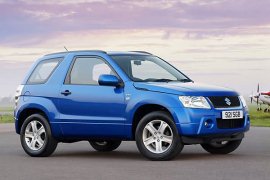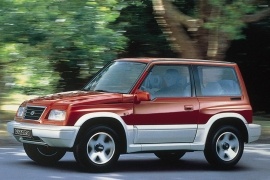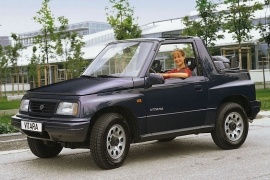SUZUKI Escudo / Vitara 3 Doors Models/Series Timeline, Specifications & Photos
First production year: 1989
Engines: Gasoline, Diesel
Body style: SUV (Sports Utility Vehicle)
Suzuki introduced the third generation of the Escudo/Vitara in 2005 and offered it with either three or five doors, depending on the market.
While the long version, with five doors, was named Grand Vitara, the three-door model lost the "Grand" from its nameplate for an obvious reason: it was shorter. Maybe it wasn't that practical for transporting family and friends around, but it could fit easier in tight parking spots. In addition, the drivers didn't have to worry if they hit a curb or if there were any drainage systems that could trap their cars.
Gone were the rounded shapes of the bio-design era, and Suzuki took advantage of it when it penned the Vitara. With its sharp lines and curved panels, it blended into the new-edge design trend that conquered the market. At the front, the Vitara featured big, rectangular headlights placed high above the tall bumper to protect them against shopping carts and bushes alike. From its profile, the two-door version featured a raked-forward B-pillar, which was not fitted on its longer sibling. That left the rear passengers with smaller side windows ending at the back on the tilted C-pillars. Suzuki chose to install the spare wheel on the tailgate, leaving more room for the trunk area.
Inside, despite the hard-plastic materials used on most of the panels and dashboard, the cabin offered a pleasant ambiance. The clean design was disturbed only by the numerous buttons on the center stack, where the buttons for the audio and HVAC systems were placed. In the back, there was very limited room for passengers, while the trunk was large enough for just a few backpacks.
Under the hood, the Japanese carmaker installed either a 1.6-liter gasoline engine or a 1.9-liter (Fiat-sourced) turbo-diesel, depending on the market. Power went to all four wheels via a two-speed transfer case and a five-speed manual.
Suzuki introduced the Vitara lineup in 1988 as a 1989 model for those looking for a light SUV but needed more room and comfort than the rugged Samurai.
The Japanese carmaker didn't want to use a chassis anymore and tried to increase comfort and features inside the vehicle. It resulted in one of the most popular SUVs in the compact-segment from the early '90s, the Vitara. Designed as a unit-body vehicle, available as a three-door hard-top or two-door convertible, the Vitara was known for its lightweight and the fuel-efficiency that made it very useful in urban traffic.
The exterior was a mix of straight-line and curved panels. Its designers installed enlarged fenders over the wheel-arches to make the car looks more muscular. In the rear, the tiny taillights installed above the bumpers were protected by annoying parking scratches.
Inside, there were two comfortable seats at the front and a small bench in the back fit for two children or not-so-tall adults. The car provided limited legroom, and the main reason it featured a bench was to expand the, otherwise, tiny trunk. In fact, it was so small that the carmaker couldn't place the spare-wheel inside the vehicle.
Under the hood, Suzuki installed a choice of three engines, depending on the market. All of them were paired as standard to a 5-speed transmission. A transfer-case ensured the 4x4 system.
Known as a big maker of small cars and motorcycles, Suzuki tried to build a small SUV and launched it in 1989: the Vitara. It was built in three variants: three-door, five-door and convertible. The same car was known in the U.S. as the Geo Sidekick or GMC Sidekick. The small engine and light body-on-frame vehicle had a good fuel consumption and decent performance on road.
For off-road use, it had a 4x4 system with a transfer box and hi-low range. Front independent suspension ensured decent comfort for the occupants. The rear live-axle was good in off-road even if it didn't have a lockable differential.
The interior features were minimal: air-conditioning, a radio-cassette player and that was it. An automatic 4-speed transmission was available as an option, but the standard was a 5-speed manual. In Europe, it was known as the Suzuki Vitara and it has a 1.6-liter engine with 80 hp. Later on, a 2.0-liter V6 gasoline engine was added, and a 2.0-liter diesel unit from Mazda.
It wasn't until 1990 when the 16 valve engine with 100 hp was installed. The aging Suzuki Vitara convertible received a facelift in 1996 and new engines were installed. The 1.6-liter unit was replaced with a four-pot 2.0-liter engine, and the 2.0-liter V6 was replaced with a 2.5-liter V6 gasoline unit. In 1998, a new generation was launched.


